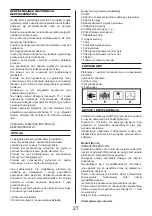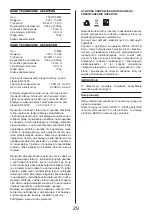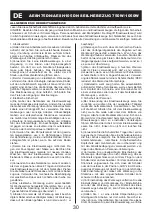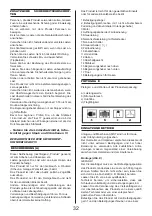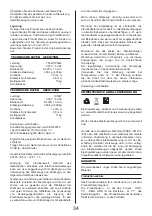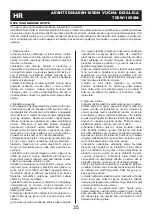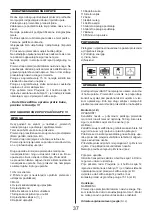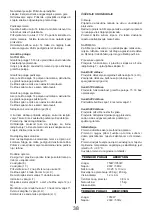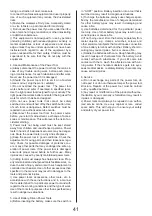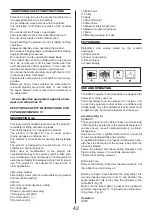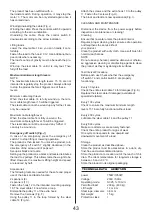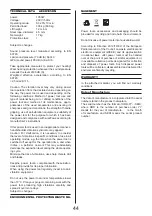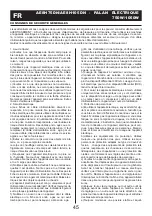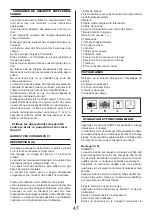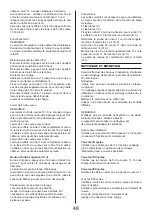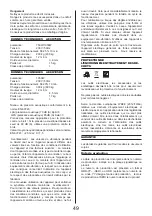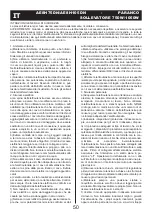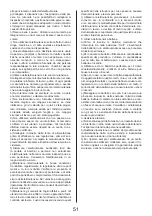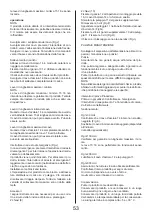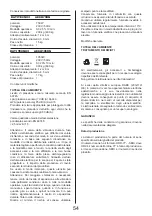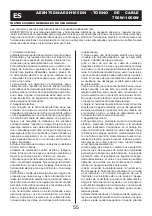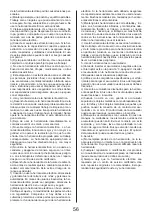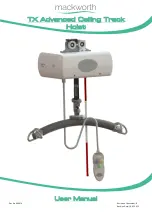
41
turing or extraction of dust, make sure
to connect the aforesaid equipment and use it properly.
Use of such equipment may reduce the dust-related
risks.
h) Fasten the workpiece firmly. Use a carpentry clamp
or a vice to fasten a part intended for machining.
i) Dot not use the power tool, if you are under the influ
-
ence of alcohol, drugs, medication or other intoxicating
or addictive substances.
j) This equipment is not designed for use by persons
(including children) with reduced physical, sensory or
mental capabilities or lack of experience and knowl
-
edge, unless they are under supervision or have been
instructed with regard to use of the equipment by a
person responsible for their safety. Children must be
supervised to be sure that they do not play with the
equipment.
4. Use and Maintenance of the Power Tool
a) Always disconnect the power tool from the mains in
case of any trouble during work, before each clean
-
ing or maintenance, for each relocation and after work.
Never use the power tool if it is damaged.
b) Should the power tool start to emit an abnormal
noise or odour, stop the work i ediately.
c) Do not overload the power tool. The power tool
works better and safer if operated in specified rpms.
Use the right power tool designed for your activity. The
right power tool works better and safer if being used for
work for which it has been designed.
d) Do not use power tools that cannot be safely
switched on and switched off by the switch button. Use
of such tools is dangerous. Defect switches must be
repaired in an authorized service centre.
e) Disconnect the power tool from the power source
before your start its adjustment, exchange of acces
-
sories or maintenance. This will prevent the risk of ac
-
cidental starting.
f) Power tools not being used must be kept stored
away from children and unauthorized persons. Power
tools in hands of inexperienced users may be danger
-
ous. Store the power tools in a dry and safe place.
g) Keep the power tool in good conditions. Check the
adjustment of moving parts and their looseness regu
-
larly. Check for possible damages of protective cov
-
ers or any other parts that may endanger the safe op
-
eration of power tools. If the power tool is damaged,
ensure its proper repair before its further use. Many
injuries are caused by poorly maintained power tools.
h) Cutting tools must always be sharp and clean. Prop
-
erly maintained and sharpened tools facilitate work, re
-
duce the risk of injury and work with such equipment is
controlled much easier. Use of other accessories than
specified in the manual may result in damages to the
tools and personal injuries.
i) Use power tools, accessories, other tools, etc. in
accordance with these instructions and in a manner
that is determined for a particular power tool and with
regard to the working conditions and the type of work.
Use of the tools for purposes other than specified may
result in dangerous situations.
5. Use of Battery-Driven Power Tools
a) Before inserting the battery, make sure the switch is
in “0-OFF” position. Battery insertion into a tool that is
switched on may result in dangerous situations.
b) To charge the batteries, always use chargers speci
-
fied by the manufacturer. Use of chargers determined
for other battery types may result in damaging and
cause a fire.
c) Use batteries determined for the particular power
tool only. Use of other battery types may result in per
-
sonal injuries or cause a fire.
d) If not being used, store the battery separately from
metal objects, e.g. clamps, wrenches, screws and
other small metal objects that could cause connection
of one battery terminal with another. Battery short-cir
-
cuiting may cause injuries, burns or cause a fire.
e) Handle the batteries with care. Rough handling may
result in leakage of chemicals from the battery. Avoid
contact with such substances. If you still come into
contact with them, wash the affected area with run
-
ning water. If the chemical substance gets into eyes,
seek medical advice i ediately. Battery chemicals may
cause serious injuries.
6. Service
a) Do not exchange any parts of the power tool, do
not repair it or do not otherwise temper the power tool
structure. Repairs of the power tool must be carried
out by qualified persons.
b) Any repair or modification of the product without au
-
thorization by our company is forbidden (may result in
injuries or damages).
c) Power tools must always be repaired in an author
-
ized service centre. Use only original or reco ended
spare parts. This will help you to ensure your safety
and safety of your power tool.

